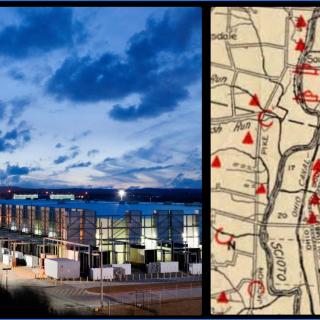Advertisement
Flying robots built for war (Anduril) aren’t the only robots coming to Rickenbacker International Airport – one of the world’s busiest logistic hubs.
These robots, however, won’t obliterate you on the spot. But they and their corporate masters could vaporize thousands of decent-paying warehouse jobs from Central Ohio – and do so without a second thought for the human beings who’ve toiled in these warehouses for years.
“Robots are taking over, and that’s a good thing for warehouse professionals!” claims this robotics manufacturer.
Rickenbacker is home to Foreign Trade Zone #138, where scores of warehouses have overtaken the prairie. “The Columbus Way” loves to brag how half the nation’s population can be reached from this “FTZ” in a day’s drive. It also is exempt from US Customs duty fees making it even more lucrative for their ultra-rich pals. This Far South Side relic of an Air Force base has been transformed into the perfect landing spot for overseas goods made in sweat shops – just ask Les Wexner and his pal Epstein (if you could).
Twenty-five billion dollars has come through Rickenbacker annually since 2023, much of it clothes and shoes, such as The Gap and L Brands. These goods need to be shipped around the clock, and this has provided the region with thousands of jobs for hardworking yet marginally skilled worker, and a sizeable percentage are immigrants. We’ve said it before – no one works harder in Columbus than the pick-packers and forklift drivers within these warehouses.
What’s more, an argument can be made that warehouses have had a huge influence on 21st century Columbus becoming one of the last Midwest boomtowns.
“Warehousing has become a major and rapidly growing sector of employment for Ohioans across many backgrounds, including immigrant and low-wage workers,” stated Isbel Alvarado of the Central Ohio Worker Center to the Free Press in an email. “Warehouse jobs offer immediate access to employment without requiring formal education, English fluency, or previous U.S. work experience, which makes them essential for many immigrant and low-wage workers. Even so, warehouse work is demanding-fast pace, high injury risks, and constant productivity pressure are common.”
Amazon has a one-million-square-foot “fulfillment center” at Rickenbacker, and just in time for the holidays is a New York Times report detailing how the e-commerce giant has a secret plan to automate 600,000 jobs by 2030, or up to 75 percent of all operational processes. No doubt, the other corporate tenants entrenched at Rickenbacker also are scheming to replace human labor with machines. Instead of giving the hardest workers in town a raise, billions will be spent on replacing them.
And not just at Rickenbacker, Amazon and others occupy warehouses in West Jefferson, providing hundreds of jobs for that neck of the woods. Advocating for all local warehouse workers is the Mid-Ohio Workers Association (MWA), a free voluntary membership association of service workers, part-time and temporary workers, domestic workers and other low-paid workers.
“Warehouse workers are some of the hardest working people in the local economy,” stated MWA operations manager Benjamin Lee in an email. “Warehouses also make heavy use of temporary workers: currently, 4,500 temporary workers work at 46 corporations (including Amazon and Goodyear) with warehousing operations based near Rickenbacker Airport, the site of the largest warehouse boom in the region over the past decade.”
It’s safe to say Rickenbacker offers the ultra-rich (Les Wexner) a triple dose of exploitation. Connecting super cheap manufacturing labor overseas to cheap logistics labor in America, where our government provides generous tax breaks to the corporations which are simply purchasing and transporting these goods from other countries.
“Rickenbacker Airport received over $100 million in county, state and federal taxpayer subsidies, on top of a 15-year 100 percent property tax abatement, as well as a waiver of importing and inventorying taxes,” stated Lee.
Central Ohio warehouse workers want safe work environments and a living wage with which to support their families in the face of Columbus’ rapidly rising cost of living, adds Lee.
“Automation could, theoretically, be used to achieve increased safety at the workplace,” he said. “However, historically, when automation is deployed by multinational corporations whose legal obligation is to maximize profits, the consequence has been unemployment, displacement and hardship.”
Despite the conditions in warehouses and below-average pay, Alvarado says “warehouse jobs remain a critical source of income that supports families and entire communities.”
“Large-scale automation plans raise serious concerns about job elimination, economic instability, and the reduction of pathways to stable work,” she said.
En Español
Invasión de los robots asesinos de trabajos
26 noviembre 2025
de la Redacción
traducción: NS
Robots voladores bélicos de la empresa Andruil no son los únicos que se esperan en el aeropuerto internacional Rickenbacker, que figura entre los ejes logísticos más ocupadas del mundo.
No te van a evaporizar en un instante, pero sus dueños corporativos volatizarán a miles de trabajos con salarios dignos del lado sureño de la zona metropolitana columbuseña, sin el más mínimo remordimiento para los seres humanos que perseveraron por años.
“Los robots asedian, y eso es bueno para los profesionistas del almacenamiento”, alardea el fabricante de robots Warehouse Rack & Shelf LLC.
El aeropuerto Rickenbacker es sede al Área de Comercio Extranjero 138 (FTZ) donde docenas de naves industriales desplazan la pradera. No sólo es cierto que la mitad de la población de los EE.UU. radica dentro de un día de carretera del Área, tal y como ufana la “Vía Columbus” (CW), sino también está exento de los derechos aduanales, enriqueciendo todavía más los acaudalados. Transformaron estos remanentes de la base de fuerza aérea al extremo sur de la zona metropolitana en el nodo para la importación de mercancías elaboradas en talleres semi esclavos, al decir de Lex Wexner y su gemelo del alma Epstein.
La cantidad de mercancía que ha pasado por el aeropuerto Rickenbacker en los últimos dos años supera a los veinticinco mil millones de dólares, en gran parte de ello fue moda, vestuario y zapato de The Gap y L Brands. La urgencia de entregar justo a tiempo en cualquiera hora del día trajo miles de puestos para trabajo duro y poco calificado, mucho de ello para inmigrantes. Tal y como hemos predicado: nadie en Columbus labora más que los bodegueros que empacan y conducen los montacargas.
Es más, es posible afirmar que fueron las almacenas que transformaron a Columbus en una de las pocas ciudades prósperas en toda la pradera en este siglo XXI.
“Almacenaje se convirtió en un sector eje y dinámica, con empleo en expansión para ohioanos con perfiles diversos, incluso para obreros generales e inmigrantes —señala Isbel Alvarado del Central de Trabajadores del Centro de Ohio (COWC) en un comunicado a la Free Press—. El oficio de bodeguero abre acceso directo a empleos sin escolaridad, fluidez en inglés o experiencia laboral en los EE.UU., aspectos claves para trabajadores generales e inmigrantes. De todas maneras, estar en el almacén implica un ritmo exigente, alto riesgo de heridas y presiones para mayor productividad.”
Rickenbacker también hospeda para el gigante de e-comercio Amazon su llamado “centro de consecución”. Justo para la temporada navideña el diario New York Times ventanea su proyecto secreto para automatizar 600,000 puestos antes del año 2030, alrededor de 75 por ciento de los procesos operativos en su nave que mide 92,903 metros cuadrados. Sin lugar a dudas, los demás inquilinos tienen planes de semejantes para suplantar a la mano de obra humana con maquinaria, en otras palabras, en lugar de ofrecerles aumentos en salario se pretende gastar miles de millones en desplazar a los que más laboran.
Amazon también opera al lado ponente de la zona metropolitana, contratando a cientos de personas del pueblo de Jefferson Occidental donde la Asociación de Trabajadores del Centro de Ohio (MWA) defiende los derechos de todos los bodegueros de la región, con inscripción voluntaria de trabajadores de servicios, de medio tiempo y temporales, domésticos y anexos de salarios mínimos.
Benjamin Lee, director de operaciones de la MWA relata como “Los bodegueros son que los trabajos más arduos en la economía del condado (de Madison). Los almacenes tienen una proporción alta de puestos temporales: en la actualidad 46 corporaciones contratan a cuatro mil quinientos temporales, (incluyendo a Amazon y Goodyear). Establecieron sus operaciones de almacenamiento en la cercanía del aeropuerto Rickenbacker, que es sede a la explosiva ampliación de naves en la última década.”
A ciencia cierta Rickenbacker alberga para los híperricos como Les Wexner una dosis triple de explotación, reuniendo mano de obra manufacturera en ultramar con labor logística barata en los EE.UU. donde el gobierno perdona los impuestos a las empresas que simplemente compran y transportan estas mercancías de otros países.
“El aeropuerto fue beneficiario de subsidios mayores de cien millones de dólares de las contribuciones a nivel condado, estatal y federal, más un descuento de cien por ciento en predial por 15 años, aparte y adicional de perdonarle los impuestos de importación e inventario,” Lee detalló.
Añadió que los bodegueros buscan ambientes laborales seguros con salarios que sostienen sus familias de cara a la erosión vertiginosa en el poder adquisitivo.
“En teoría la automación aumentaría la seguridad en la fuente de trabajo —admite—, sin embargo la historia muestra que las extensiones tecnológicas de la multinacionales con la misión de maximizar las ganancias, las consecuencias siempre fueron desempleo, desplazo de puestos y malestar.”
A pesar de que las condiciones y salarios bajos en las bodegas —continúa— “los puestos representan todavía fuentes de ingreso claves que mantienen familias y comunidades enteras.”
Alvarado concluyó con la observación que “la automatización a grandes escalas encausa a inquietudes graves sobre la eliminación de fuentes de trabajo, inestabilidad económica y restricción de rutas a trabajos estables.”



